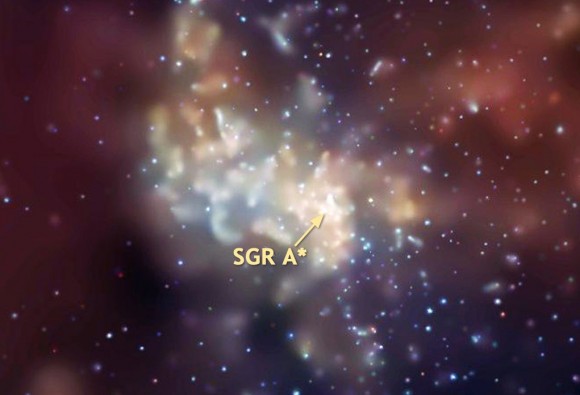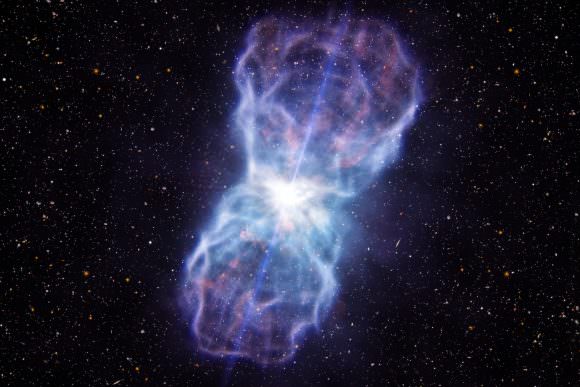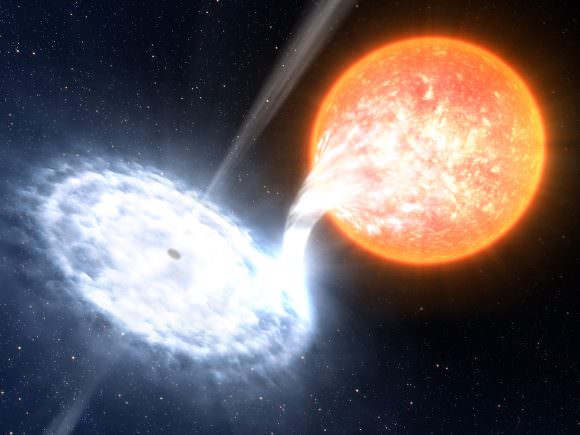Want to hear something cool? There’s a black hole at the center of the Milky Way. And not just any black hole, it’s a supermassive black hole with more than 4.1 million times the mass of the Sun.
It’s right over there, in the direction of the Sagittarius constellation. Located just 26,000 light-years away. And as we speak, it’s in the process of tearing apart entire stars and star systems, occasionally consuming them, adding to its mass like a voracious shark.

Wait, that doesn’t sound cool, that sort of sounds a little scary. Right?
Don’t worry, you have absolutely nothing to worry about, unless you plan to live for quadrillions of years, which I do, thanks to my future robot body. I’m ready for my singularity, Dr. Kurzweil.
Is the supermassive black hole going to consume the Milky Way? If not, why not? If so, why so?
The discovery of a supermassive black hole at the heart of the Milky Way, and really almost all galaxies, is one of my favorite discoveries in the field of astronomy. It’s one of those insights that simultaneously answered some questions, and opened up even more.
Back in the 1970s, the astronomers Bruce Balick and Robert Brown realized that there was an intense source of radio emissions coming from the very center of the Milky Way, in the constellation Sagittarius.
They designated it Sgr A*. The asterisk stands for exciting. You think I’m joking, but I’m not. For once, I’m not joking.

In 2002, astronomers observed that there were stars zipping past this object, like comets on elliptical paths going around the Sun. Imagine the mass of our Sun, and the tremendous power it would take to wrench a star like that around.
The only objects with that much density and gravity are black holes, but in this case, a black hole with millions of times the mass of our own Sun: a supermassive black hole.
With the discovery of the Milky Way’s supermassive black hole, astronomers found evidence that there are black holes at the heart of every galaxy.
At the same time, the discovery of supermassive black holes helped answer one of the big questions in astronomy: what are quasars? We did a whole article on them, but they’re intensely bright objects, generating enough light they can be seen billions of light-years away. Giving off more energy than the rest of their own galaxy combined.

It turns out that quasars and supermassive black holes are the same thing. Quasars are just black holes in the process of actively feeding; gobbling up so much material it piles up in an accretion disk around it. Once again, these do sound terrifying. But are we in any danger?
In the short term, no. The black hole at the center of the Milky Way is 26,000 light-years away. Even if it turned into a quasar and started eating stars, you wouldn’t even be able to notice it from this distance.
A black hole is just a concentration of mass in a very small region, which things orbit around. To give you an example, you could replace the Sun with a black hole with the exact same mass, and nothing would change. I mean, we’d all freeze because there wasn’t a Sun in the sky anymore, but the Earth would continue to orbit this black hole in exactly the same orbit, for billions of years.
Same goes with the black hole at the center of the Milky Way. It’s not pulling material in like a vacuum cleaner, it serves as a gravitational anchor for a group of stars to orbit around, for billions of years.
In order for a black hole to actually consume a star, it needs to make a direct hit. To get within the event horizon, which is only about 17 times bigger than the Sun. If a star gets close, without hitting, it’ll get torn apart, but still, it doesn’t happen very often.

The problem happens when these stars interact with one another through their own gravity, and mess with each other’s orbits. A star that would have been orbiting happily for billions of years might get deflected into a collision course with the black hole. But this happens very rarely.
Over the short term, that supermassive black hole is totally harmless. Especially from out here in the galactic suburbs.
But there are a few situations that might cause some problems over vast periods of time.
The first panic will happen when the Milky Way collides with Andromeda in about 4 billion years – let’s call this mess Milkdromeda. Suddenly, you’ll have two whole clouds of stars interacting in all kinds of ways, like an unstable blended family. Stars that would have been safe will careen past other stars and be deflected down into the maw of either of the two supermassive black holes on hand. Andromeda’s black hole could be 100 million times the mass of the Sun, so it’s a bigger target for stars with a death wish.

Over the coming billions, trillions and quadrillions of years, more and more galaxies will collide with Milkdromeda, bringing new supermassive black holes and more stars to the chaos.
So many opportunities for mayhem.
Of course, the Sun will die in about 5 billion years, so this future won’t be our problem. Well, fine, with my eternal robot body, it might still be my problem.
After our neighborhood is completely out of galaxies to consume, then there will just be countless eons of time for stars to interact for orbit after orbit. Some will get flung out of Milkdromeda, some will be hurled down into the black hole.
And others will be safe, assuming they can avoid this fate over the Googol years it’ll take for the supermassive black hole to finally evaporate. That’s a 1 followed by 100 zeroes years. That’s a really really long time, so now I don’t like those odds.
For our purposes, the black hole at the heart of the Milky Way is completely and totally safe. In the lifetime of the Sun, it won’t interact with us in any way, or consume more than a handful of stars.
But over the vast eons, it could be a different story. I hope we can be around to find out the answer.


Danger, Will Robinson!
Fraser……..rather than regurgitate preposterous concepts that have no scientific basis perhaps you might consider some theories that have observational validity and are experimentally verifiable.
My first objection is your use of the term “black hole”. This massive and enormously powerful structure found at the center of our galaxy (and almost every other galaxy) is neither black nor can it be a “hole” in anything. By who, when and why was this term chosen. The latest radio telescope data has revealed these galactic center structures emit multiple plasma jets, EM radiation (gamma and x ray) as well as visible light. These findings required the addition of the “accretion disc” since they invalidated the model that said the gravity was so powerful even light could not escape. I wonder how the accretion disc (or whatever) sits above the gravitational forces with impunity. I’m sure there is a mathematical explanation which, thank goodness, obviates the need for any radio telescope data.
But what is really curious is the recent documentation of massive, and I mean colossal, magnetic fields surrounding these galactic centers. This finding is being basically ignored by astrophysicists and cosmologists when the evidence should be the topic of every scientific conversation regarding these galactic centers (“black holes”).
It’s important to ignore these magnetic fields, the electric currents that cause them and the underlying plasma morphology of which they consist.
btraymd……..rather than regurgitate preposterous concepts that have no scientific basis perhaps you might consider some theories that have observational validity and are experimentally verifiable… for instance, I don’t know, the known behavior of the EM force in the first place?
Seriously, how are you going to ignore the known rules covering the electromagnetic force AND THEN propose that that same force is responsible for what we see in the cosmos in exact conflict with those same rules? Even if we DIDN’T have Relativity to fall back on, that’s a special kind of illogical.
Not to be boring but there are some observations which make common sense and have an important experimentally verified foundation.
First, gravity is too weak to be the cause of galaxy formation. The mathematical creation of dark matter to salvage this idea has no scientific, experimental or observational support.
Everyone should revisit the basic research performed by plasma physicist Anthony Peratt at Los Alamos National Labs in the 80’s. His work has been confirmed by many plasma physic labs and his findings have not been refuted to this day. They have just been ridiculed and ignored. Sound familiar???
This Nobel Prize winning (eventually) work by Peratt showed the formation of spiral galaxies using only electric current, plasma and magnetic fields. Black holes and dark matter were not required. These formations also had the necessary velocities to maintain galactic structure.
If ever the principle of Occam’s Razor needs to be applied, this is it.
For the G.U.T., think electromagnetism, not gravity. It’s Faraday, Alvfens, Birkeland and Tesla ( and many others such as Velikosky, Jurrgens, Scott and Thornhill)……not Einstein.
Point by point, then:
“First, gravity is too weak to be the cause of galaxy formation.”
1) “Straw Man:” for the most part, gravity just holds the collection together.
“The… creation of dark matter … has no scientific, experimental or observational support.”
2) FALSE: observation itself is what requires “dark matter” exist, the only mystery being what it’s made of.
“The basic research… by Peratt showed the formation of spiral galaxies using only electric current, plasma and magnetic fields.”
3) FALSE: the experiments were done in the 1950’s by Winston H. Bostick, producing galaxy-shaped structures; Peratt’s work was an immense extrapolation of those results.
“If ever the principle of Occam’s Razor needs to be applied, this is it.”
4) TRUE. Since we know the EM force loses/gains strength too fast w/distance to do anything but collapse or explode the galactic structures we see, it cannot be the main force responsible for maintaining them.
“For the G.U.T., think electromagnetism, not gravity. It’s [a list of folks]…not Einstein.”
5) UNKNOWN, however Einstein’s work is at least validated by observation & testing, unlike the Electric/Plasma Universe concept. In addition (& ALSO unlike the E.U. idea), it does not require ignoring the laws of electromagnetism (of all things!) in order to work.
If interstellar space was filled with plasma to allow conduction, as maintained, the braking effect on stellar motion would be greater than observed.
Another problem, unless there is a source of energy from fusion, fission, radioactive decay or stored,
all plasmas will eventually condense due to the effects of relative motion, and the net positive charge of the ionized atom recapturing the electron(s).
The conservation of energy is maintained by the emission of light or other frequencies of EM radiation depending on the shell transition by the electron.
This effect outweighs the photoelectric effect.
The example of the fluorescent tube can not be used as a counter argument because the source of energy is electricity generated from stored sunlight (coal).
To the contrary. When the electrical energy source is removed, any mercury plasma condenses to mercury vapour, and the light goes out.
To my knowledge, not all galaxies have supermassive black holes within them. Specifically, small irregular galaxies (like the Large and Small Magellanic Clouds) do not. This is consistent with my personal theory that most, if not all, irregular galaxies are remnants of galactic collisions and cannibalism.
If I’m mistaken – for instance, if there are supermassive black holes associated with the Magellanic Clouds – I’d like someone to let me know, and give me a reference so I can learn more.